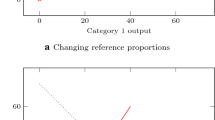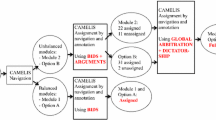Abstract
This paper examines the case of a procurement auction for a single project, in which the breakdown of the winning bid into its component items determines the value of payments subsequently made to bidder as the work progresses. Unbalanced bidding, or bid skewing, involves the uneven distribution of mark-up among the component items in such a way as to attempt to derive increased benefit to the unbalancer but without involving any change in the total bid. One form of unbalanced bidding for example, termed Front Loading (FL), is thought to be widespread in practice. This involves overpricing the work items that occur early in the project and underpricing the work items that occur later in the project in order to enhance the bidder's cash flow. Naturally, auctioners attempt to protect themselves from the effects of unbalancing—typically reserving the right to reject a bid that has been detected as unbalanced. As a result, models have been developed to both unbalance bids and detect unbalanced bids but virtually nothing is known of their use, success or otherwise. This is of particular concern for the detection methods as, without testing, there is no way of knowing the extent to which unbalanced bids are remaining undetected or balanced bids are being falsely detected as unbalanced. This paper reports on a simulation study aimed at demonstrating the likely effects of unbalanced bid detection models in a deterministic environment involving FL unbalancing in a Texas DOT detection setting, in which bids are deemed to be unbalanced if an item exceeds a maximum (or fails to reach a minimum) ‘cut-off’ value determined by the Texas method. A proportion of bids are automatically and maximally unbalanced over a long series of simulated contract projects and the profits and detection rates of both the balancers and unbalancers are compared. The results show that, as expected, the balanced bids are often incorrectly detected as unbalanced, with the rate of (mis)detection increasing with the proportion of FL bidders in the auction. It is also shown that, while the profit for balanced bidders remains the same irrespective of the number of FL bidders involved, the FL bidder's profit increases with the greater proportion of FL bidders present in the auction. Sensitivity tests show the results to be generally robust, with (mis)detection rates increasing further when there are fewer bidders in the auction and when more data are averaged to determine the baseline value, but being smaller or larger with increased cut-off values and increased cost and estimate variability depending on the number of FL bidders involved. The FL bidder's expected benefit from unbalancing, on the other hand, increases, when there are fewer bidders in the auction. It also increases when the cut-off rate and discount rate is increased, when there is less variability in the costs and their estimates, and when less data are used in setting the baseline values.






Similar content being viewed by others
Notes
Following Stark (1974, p 373) these terms are used interchangeably: bidding, tendering; unit price, unit bid, bill rate; bidder, contractor; auctioner, seller, owner, client, sponsor; Unit Price Proposal, Bill of Quantities; unbalancing, loading of bill rates; front loading, front end loading.
As Stark notes, some construction projects, such as highways and maintenance, are ‘more a challenge of finance than of technology’ (Stark, 1974, p 375).
This is to be compared to real-world conditions, where a project might comprise thousands of items.
References
Afshar A and Amiri H (2008). A fuzzy-based model for unbalanced bidding in construction. In: Lodi SH, Ahmed SM, Farooqui RU and Saqib M (eds). Proceedings of the First International Conference on Construction in Developing Countries (ICCIDC-1). 4–5 August, Department of Civil Engineering, NED University of Engineering & Technology; Karachi, Pakistan, pp 57–63.
Arditi D and Chotibhong R (2009). Detection and prevention of unbalanced bids. Construction Management and Economics 27 (8): 721–732.
Ashley DB and Teicholz PM (1977). Pre-estimate cash flow analysis. Journal of the Construction Division, American Society of Civil Engineers 103 (3): 369–379.
Athey S and Levin J (2001). Information and competition in US Forestry Service timber auctions. Journal of Political Economy 109 (2): 375–417.
Bajari P, Houghton S and Tadelis S (2006). Bidding for Incomplete Contracts: An Empirical Analysis of Adaptation Costs. FEEM working paper 141.04, Ann Arbor, http://papers.ssrn.com/Sol3/papers.cfm?abstract_id=624442, accessed 28 May 2010.
Beeston DT (1975). One statistician's view of estimating. Chartered Surveyor, Building and Quantity Surveying Quarterly 12 (4): 49–54.
Cattell DW (1984). A model for item price loading by building contractors. Department of Quantity Surveying, University of the Witwatersrand, Johannesburg, South Africa, Unpublished.
Cattell DW (1987). Item price loading. In: Proceedings of the PACE’87 Progress in Architecture, Construction and Engineering. Vol. II, South Africa Council for Scientific & Industrial Research; Johannesburg, South Africa, pp 1–20.
Cattell DW (2009). Component unit pricing theory. Unpublished PhD Thesis, Department of Construction Economics and Management, University of Cape Town, South Africa.
Cattell DW, Bowen PA and Kaka AP (2007). Review of unbalanced bidding models in construction. Journal of Construction Engineering and Management, American Society of Civil Engineers 133 (8): 562–573.
Cattell DW, Bowen PA and Kaka AP (2008). A simplified unbalanced bidding model. Construction Management and Economics 26 (12): 1283–1290.
Chawner LJ (1935). Cost indexes as influenced by technological change and other factors. Journal of the American Statistical Society 30 (191): 561–576.
Christodoulou SE (2008). A bid-unbalancing method for lowering a contractor's financial risk. Construction Management and Economics 26 (12): 1291–1302.
Clough RH and Sears GA (1994). Construction Contracting, 6th edn. John Wiley & Sons: New York.
Diekmann JE, Mayer Jr. RH and Stark RM (1982). Coping with uncertainty in unit price contracting. Journal of the Construction Division, American Society of Civil Engineers 108 (3): 379–389.
Doersch RH and Patterson JH (1977). Scheduling a project to maximise its present value: A zero-one programming approach. Management Science 23 (8): 882–889.
Gates M (1959). Aspects of competitive bidding. Annual Report, Connecticut Society of Civil Engineers.
Gates M (1967). Bidding strategies and probabilities. Journal of the Construction Division, American Society of Civil Engineers 93 (C01): 75–107.
Green SD (1986). The Unbalancing of Tenders. MSc Dissertation, Department of Building, Heriot-Watt University.
Haley MR and Dunphey CR (2010). On the Athey-Levin model of skewed bidding. Applied Economics Letters 17 (8): 727–732.
Hinze J (1993). Construction Contracts. Irwin McGraw-Hill: Boston.
Kenley R (2003). Construction financing: Cash Flows and Cash Farming. Spon Press: London.
Liu X, Ling L and Zang D (2009). Stochastic programming models and hybrid intelligent algorithm for unbalanced bidding problem. Computer and Information Science 2 (1): 188–194.
Rothkopf MH and Harstad RM (1994). Modelling competitive bidding: A critical essay. Management Science 40 (3): 364–384.
Rousseau J (1756). A Lasting Peace through the Federation of Europe and the State of War. C.E. Vaughan (trans.) Constable and Co: London, 1917.
Stark RM (1968). Unbalanced bidding models-theory. Journal of the Construction Division, American Society of Civil Engineers 94 (CO2): 197–209.
Stark RM (1972). Unbalancing of tenders. Proceedings of the Institute of Civil Engineers 51 (2): 391–392.
Stark RM (1974). Unbalanced highway contract tendering. Operations Research Quarterly 25 (3): 373–388.
Tong Y and Lu Y (1992). Unbalanced bidding on contracts with variation trends in client-provided quantities. Construction Management and Economics 10 (1): 69–80.
Wang W-C (2004). Electronic-based procedure for managing unbalanced bids. Journal of Construction Engineering and Management 130 (3): 455–460.
Author information
Authors and Affiliations
Corresponding author
Rights and permissions
About this article
Cite this article
Skitmore, M., Cattell, D. On being balanced in an unbalanced world. J Oper Res Soc 64, 138–146 (2013). https://doi.org/10.1057/jors.2012.29
Received:
Accepted:
Published:
Issue Date:
DOI: https://doi.org/10.1057/jors.2012.29




